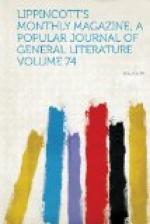Along the Via San Basilio the two men walked until they stood opposite the door of No. 51. Sacred ground this, and historical as well. Art had her votaries here, as the tourist of to-day will find she still has, at whose shrines pilgrims from afar and from near worshiped, and grew better and stronger for their ministrations. Crawford, then at the acme of his fame, had his constantly-thronged studio in the immediate vicinity, while those at No. 51 embraced, among others, that of Tenerani, the famous Italian sculptor, whose work is always in such fine dramatic taste, although he never sacrifices his love and deep feeling of reverence for Nature, combining that with the most delightful charms of Greek art. Among this artist’s most noted works will be remembered his “Descent from the Cross,” which tourists visiting the Torlonia chapel in the Lateran never gaze upon without a thrill. The house was owned and also occupied by Bienaime, a French sculptor who afterward became famous.
In the immediate vicinity stands the famous Palazzo Barberini, begun by Urban VIII. (Maffeo Barberini), who sat in the pontifical chair from 1623 to 1644, and finished by Bernini in 1640. This palace contains many paintings of historical interest by Raphael, Titian, Guido, Claude and others. The one by the first-mentioned artist is a Fornarina, and bears the autograph of the painter on the armlet. But the picture that attracts the most attention here is one of world-wide reputation, copies, engravings and photographs of which are everywhere to be met with—Guido’s Beatrice Cenci. A great divergence of opinion, as is well known, exists in regard to the portrait. It bears the pillar and crown of the Colonnas, to which family it probably belonged. According to the family tradition, it was taken on the night before her execution. Other accounts state that it was painted by Guido from memory after he had seen her on the scaffold. Judging from the position in which the poor girl’s head is represented, one would more readily give credence to the latter story, and think the artist’s memory had preserved her look and position as she turned her head for a last look at the brutal, bellowing crowd behind.
In the piazza of the palace is a very beautiful fountain, utilized by one of the oldest Roman statues, representing a faun blowing water from a conch-shell.
But we must return to the Via San Basilio, and the two wayfarers we left standing in front of No. 51. After gazing a moment at the number to assure themselves that they were right, they entered, and knocked at the first door, which was opened by the occupant of the apartment. He was an artist and a man of very marked characteristics. Seven years later Hawthorne wrote as follows of him: “He is a plain, homely Yankee, quite unpolished by his many years’ residence in Italy. He talks ungrammatically; walks with a strange, awkward gait and stooping shoulders; is altogether unpicturesque, but wins one’s confidence




